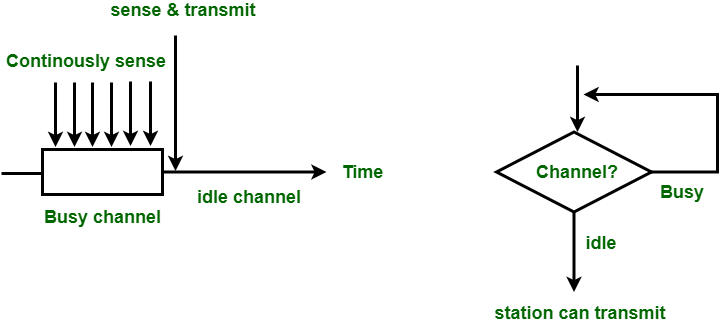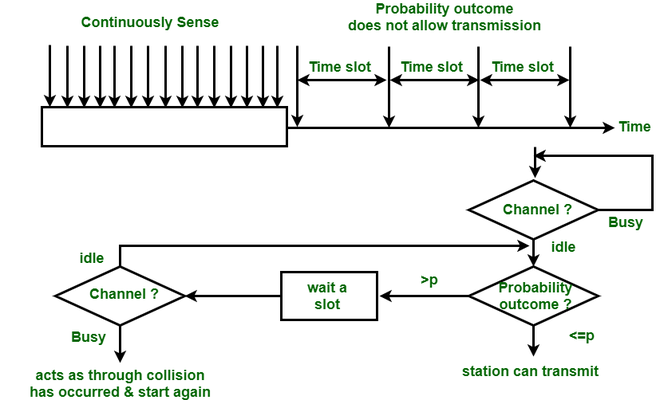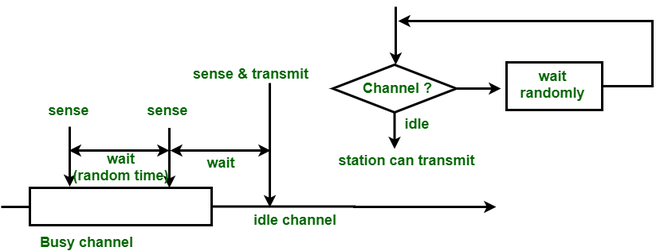先决条件–载波侦听多路访问(CSMA)
1. 1永久CSMA:
在1永久CSMA中,站点连续感测信道以检查其状态(即空闲或忙碌),以便它可以传输或不传输数据。如果信道忙,则站将等待信道变为空闲。当站点发现空闲信道时,它将无延迟地将帧发送到该信道。它以概率1发送帧。由于概率1,它被称为1-persistent CSMA。
该方法的问题在于发生冲突的机会很多,这是因为存在两个或两个以上的站同时处于空闲状态和发送帧的机会。在发生冲突的时间,站点必须等待随机时间以使信道空闲并重新开始。 
当信道具有时隙且时隙持续时间等于或大于最大传播延迟时间时,将使用此方法。当电台准备好发送帧时,它将感应到该频道。如果发现信道繁忙,则该信道将等待下一个时隙。如果发现信道空闲,则它以概率p发送帧,因此对于左概率,即q等于1-p,该站将等待下一个时隙的开始。如果发现下一个时隙也处于空闲状态,它将以概率p和q再次发送或等待。重复此过程,直到发送帧或另一个站开始发送为止。

在这种方法中,具有要发送的帧的站仅该站会感知该信道。在空闲信道的情况下,它将立即将帧发送到该信道。如果发现信道繁忙,它将等待随机时间,并再次感测该站的状态是空闲还是繁忙。在这种方法中,当站检测到先前传输的结束时,它不会立即仅出于捕获信道的目的而立即感知到该信道。使用此方法的主要优点是它减少了碰撞的机会。这样做的问题是,它降低了网络的效率。

| Parameter | 1-persistent CSMA | p-persistent CSMA | Non-persistent CSMA |
|---|---|---|---|
| Carrier Sense | It sends with the probability of 1 when channel is idle. | It sends with the probability of p when channel is idle. | It send when channel is idle. |
| Waiting | It continuously senses the channel or carrier. | It waits for the next time slot. | It will wait for the random amount of time to check the carrier. |
| Chances of Collision | There is highest chances of collision in this. | Less chances as compared to 1-persistence and p-persistence. | Less chances as compared to 1-persistence but more than the p-persistence. |
| Utilization | It’s utilization is above ALOHA as frames are only sent when the channel is idle. | It’s utilization is depend upon the probability p. | It’s utilization is above 1-persistent as not all the stations constantly check the channel at the same time. |
| Delay Low Load | It is low as frames are send when the channel become idle. | It is large when p is small as station will not always send when channel is idle. | It is small as station will send whenever channel is found idle but longer than 1-persistent since it checks for the random time when busy. |
| Delay High Load | It is high due to collision. | It is large when the probability p of sending is small when channel is idle and channel is rarely idle. | It is longer than 1-persistent as channel is checked randomly when busy. |